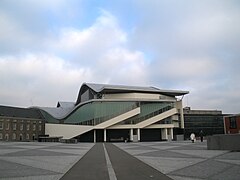Herman Hertzberger
Herman Hertzberger | |
|---|---|
 Hertzberger in 1970 | |
| Born | 6 July 1932 |
| Nationality | Dutch |
| Alma mater | Delft University of Technology |
| Occupation | Architect |
| Awards | RIBA Royal Gold Medal |
| Buildings | Montessori school, Delft (1966–70) Centraal Beheer office building, Apeldoorn (1970–72) |
| Projects | Diagoonwoningen, Delft (1971) |
Herman Hertzberger (born 6 July 1932) is one of the most famous Dutch architects, professor emeritus and the last Dutch architect to receive the prestigious Royal Gold Medal. Hertzberger is one of the oldest active Dutch architects.
Biography[]

Herman Hertzberger was born on 6 July 1932 in Amsterdam.[1]
He completed his studies at the Delft University of Technology in 1958, where he was a professor from 1970 to 1999.[1]
Career[]
Structuralism[]
Hertzberger can be considered, along with Aldo van Eyck, as the influence behind the Dutch structuralist movement of the 1960s and 1970s. Among Hertzberger's best known buildings are the experimetal houses known as "Diagoon" houses (1971), the Montessori school in Delft (1966–70) and the administration building for the Centraal Beheer Insurance Company building in Apeldoorn (1970–72). He believed that the architect's role was not to provide a complete solution, but to provide a spatial framework to be filled in by the users. This idea comes from the Participation movement, initiated in 1961 by John Habraken with his book "Supports". Herman Hertzberger was one of the first architects, who produced architectural solutions with user participation. Centraal Beheer and the "Diagoon" houses are belonging to the most inspiring examples of the international Participation movement.
Insurance company Centraal Beheer has now left the building, and at the moment it is being converted into houses with roof gardens and various shared facilities. The starting point of Hertzberger – that the building can be used for multiple functions – can be tested with this.
Hertzberger is criticized for the inelegance of the façades of his buildings, because he is more interested in the operation and the interior of the buildings he designs than in the aesthetics of the façades.[2] Later buildings with appealing facades – such as Waternet in Amsterdam – show that Hertzberger's style has evolved, also through collaboration with Laurens Jan ten Kate.
Books[]
Hertzberger has written several books including Lessons for Students in Architecture published in 1991 (ISBN 978-9064504648), Space and the Architect: Lessons in Architecture 2, 1999 (ISBN 978-9064503801) and Space and Learning in 2008 (ISBN 978-9064506444).
Herman Hertzberger, Arnulf Lüchinger, Rijk Rietveld, Herman Hertzberger 1959–86, Buildings and Projects, (English+German+French), The Hague 1987. First part of the architectural work.
Awards[]
- Richard Neutra Award for Professional Excellence 1989, California State Polytechnic University, Pomona
- RIBA Royal Gold Medal 2012[3]
- Thomas Jefferson Medal in Architecture 2015, University of Virginia[4]
He is an Accademico d'Onore, or honorary member, of the Accademia delle Arti del Disegno of Florence.[5]
Buildings[]

De Drie Hoven

De Drie Hoven, residential building for elderly people in Amsterdam-Slotervaart, 1974
De Drie Hoven, video with portrait of Herman Hertzberger

Vredenburg Music Centre in Utrecht, 1978
Vredenburg

Willemspark School in Amsterdam, 1983

Chassé Theatre in Breda, 1995

Diagoon housing in Delft, 1971

Diagoon housing, basic structure for participation
References[]
- ^ Jump up to: a b Herman Hertzberger at archINFORM
- ^ DUIC, January 25 2019
- ^ "Constructive criticism: the week in architecture". The Guardian. 9 December 2011. Retrieved 10 February 2012.
- ^ UVA Today News, 4 March 2015.
- ^ Accademici d'Onore Archived 19 June 2013 at the Wayback Machine (in Italian). Accademia delle Arti del Disegno, Florence. Accessed June 2013.
External links[]
| Wikimedia Commons has media related to Herman Hertzberger. |
- 1932 births
- Living people
- Dutch architects
- Structuralism
- Delft University of Technology alumni
- Delft University of Technology faculty
- Members of the Academy of Arts, Berlin
- Architects from Amsterdam









